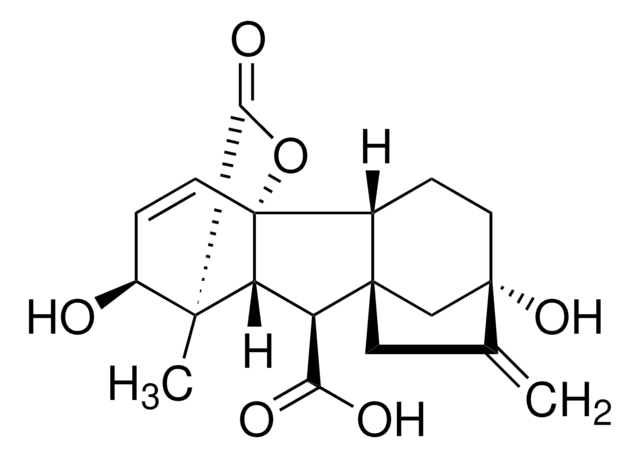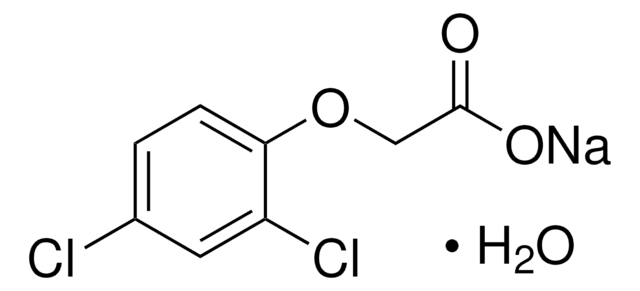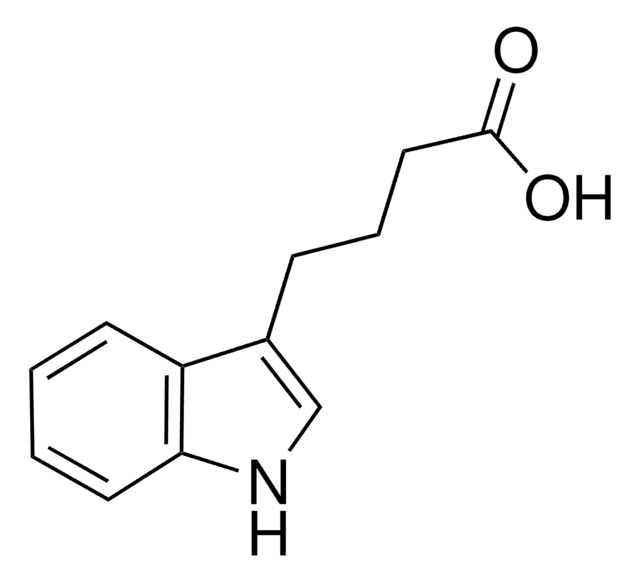추천 제품
vapor pressure
0.4 mmHg ( 160 °C)
Quality Level
분석
97%
양식
solid
mp
136-140 °C (lit.)
SMILES string
OC(=O)COc1ccc(Cl)cc1Cl
InChI
1S/C8H6Cl2O3/c9-5-1-2-7(6(10)3-5)13-4-8(11)12/h1-3H,4H2,(H,11,12)
InChI key
OVSKIKFHRZPJSS-UHFFFAOYSA-N
유사한 제품을 찾으십니까? 방문 제품 비교 안내
관련 카테고리
일반 설명
2,4-Dichlorophenoxyacetic acid is a widely used herbicide that decomposes in the presence of water and ultraviolet light to form polymeric humic acids.
신호어
Danger
유해 및 위험 성명서
Hazard Classifications
Acute Tox. 4 Oral - Aquatic Acute 1 - Aquatic Chronic 3 - Eye Dam. 1 - Skin Sens. 1 - STOT SE 3
표적 기관
Respiratory system
Storage Class Code
11 - Combustible Solids
WGK
WGK 2
Flash Point (°F)
Not applicable
Flash Point (°C)
Not applicable
개인 보호 장비
dust mask type N95 (US), Eyeshields, Faceshields, Gloves
Manoharan Rajesh et al.
Protoplasma, 251(5), 1231-1243 (2014-03-19)
Podophyllum hexandrum Royle known as Indian mayapple is an important medicinal plant found only in higher altitudes (2,700 to 4,200 m) of the Himalayas. The highly valued anticancer drug Podophyllotoxin is obtained from the roots of this plant. Due to
Heping Han et al.
Pest management science, 69(9), 996-1000 (2013-06-21)
The auxinic herbicide 2,4-D amine is known, in vitro, as a cytochrome P450 inducer. The current study uses 2,4-D pre-treatment, at the whole plant level, to study mechanism(s) of non-target site based herbicide resistance to the ACCase-inhibiting herbicide diclofop-methyl in
The microbial degradation of 2,4-dichlorophenoxyacetic acid in soil.
E R Sandmann et al.
Reviews of environmental contamination and toxicology, 101, 1-53 (1988-01-01)
Carol J Burns et al.
Critical reviews in toxicology, 42(9), 768-786 (2012-08-11)
A qualitative review of the epidemiological literature on the herbicide 2,4-dichlorophenoxyacetic acid (2,4-D) and health after 2001 is presented. In order to compare the exposure of the general population, bystanders and occupational groups, their urinary levels were also reviewed. In
Environmental genomics: mechanistic insights into toxicity of and resistance to the herbicide 2,4-D.
Miguel Cacho Teixeira et al.
Trends in biotechnology, 25(8), 363-370 (2007-06-20)
Genomic information and tools are beginning to be used to increase our understanding of how organisms of all types interact with their environment. The study of the expression of all genes, at the genome, transcriptome, proteome and metabolome level, in
자사의 과학자팀은 생명 과학, 재료 과학, 화학 합성, 크로마토그래피, 분석 및 기타 많은 영역을 포함한 모든 과학 분야에 경험이 있습니다..
고객지원팀으로 연락바랍니다.








